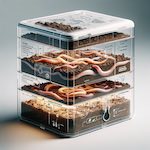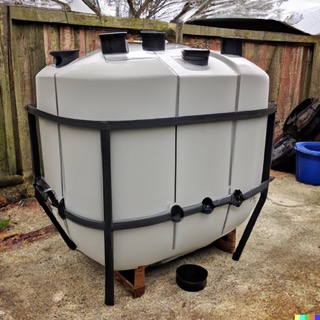
Are you looking for the best Rain Collection Tanks?
With so many options on the market, it can be challenging to choose the best Rain Collection Tanks that suits your needs.
In this guide, we'll explore the top 6 Rain Collection Tanks in 2023.
Choosing the right rain collection tank is not just about storage capacity or material. It's about understanding the broader impact of that choice. It's about sustainability, the environment, and the health of future generations. So, the next time you look up at the sky and see dark clouds, remember: that's not just rain; it's an opportunity. An opportunity to make a difference.
Rain harvesting offers:
- Reduced water bills.
- Sustainable water source.
- Reduced soil erosion.
- Reduced flood risks.
- Enhanced landscape irrigation.
- Groundwater replenishment.
- Decreased demand on municipal systems.
- Environmentally friendly.
- Improved water quality for plants.
- Emergency water supply backup.
How We Rated the Best Rain Collection Tanks for 2023:
When it comes to choosing the best rain collection tanks, we don't take our ratings lightly. Our comprehensive evaluation process is rooted in a set of well-defined criteria to ensure that you get the best value for your money and a product that aligns with your needs. Here's a breakdown of the factors we considered:
- EPA Free: We prioritize the environment and your health. Tanks that are free from harmful chemicals and meet the Environmental Protection Agency's standards rank higher on our list.
- Food Grade: Safety first! We give preference to tanks made from food-grade materials, ensuring that the water you collect remains uncontaminated and safe for various uses.
- Price Per Gallon (Inclusive of Delivery): Affordability matters. We've considered the cost-effectiveness of each tank by evaluating its price per gallon, including delivery charges, to ensure you get the best bang for your buck.
- Tank Size: Whether you're looking for a compact solution or a large storage capacity, we've rated tanks of various sizes to cater to different needs.
- Sturdiness: Durability is key. We've assessed the build quality and material strength of each tank to ensure it stands the test of time and the elements.
- Expandability Afterwards: Future-proofing is essential. Tanks that offer the option for expansion or connection to additional units score extra points, providing flexibility as your water collection needs grow.
With these criteria in mind, we've curated a list that offers a blend of quality, functionality, and value, helping you make an informed decision in your quest for the perfect rain collection tank.
Top 6 Best Rain Collection Tanks 2023:
Top 6 Best Rain Collection Tanks 2023: Comparison Table
Best Bang per Buck: Used / Refurbished IBC Container in your area
*As an eBay Affiliate, I earn commission from qualifying purchases made through links in this post.*
| Product | Link | Price ($) | Capacity (Gallons/ Liter) | Price per Gallon ($) | Location |
| 275 Gallon IBC Tote - Water Tank | https://ebay.us/l3FSAU | 100.00$ | 275 Gallons/ 1040 Liter | 0.36$ | New York |
| 275 Gallon IBC Tote - Water Tank | https://ebay.us/fGD7Tr | 99.00$ | 275 Gallons/ 1040 Liter | 0.36$ | California |
| 275 Gallon IBC Tote - Water Tank - CONTACT FOR SHIPPING QUOTES | https://ebay.us/Zr35Pd | 150.00$ | 275 Gallons/ 1040 Liter | 0.55$ | Pennsylvania |
| USED 275 Gallon IBC Tote / Fluid Container Schuetz IBC275GAL | https://ebay.us/j75gKx | 99.00$ | 275 Gallons/ 1040 Liter | 0.36$ | California |
| IBC Tote Cove, 275 Gallon IBC Water Storage Barrel Liner Bags | https://ebay.us/VRXcC0 | 122.99$ | 275 Gallons/ 1040 Liter | 0.45$ | Florida |
| IBC Tote Cove, 275 Gallon IBC Water Storage Barrel Liner Bags | https://ebay.us/FCgmdS | 73.09$ | 275 Gallons/ 1040 Liter | 0.27$ | Alabama |
| 330 Gallon IBC Tote Tank | https://ebay.us/Cs8AOU | 250.00$ | 330 Gallons/ 1250 Liter | 0.76$ | Ohio |
*As an Amazon Associate, I earn commission from qualifying purchases made through links in this post.*
| Features/Products | Link | Price Per Gallon | Price - October 2024 | Material | Capacity | Dimensions | Weight | Country of Origin | Pros | Cons |
| ENPAC Extra Large Tote Bin, Yellow, 223 Gallon, Durable, UV Resistant, 100% Polyethylene, Nestable, Forkliftable | https://amzn.to/3YrYFVT | $1.28 | $285.00 | Polyethylene (PE) | 223 Gallons/ 844 Liter | 51.5L x 47.25W x 33H inches | 55 Pounds | Not Specified | - Durable - UV Resistant - Nestable - Forkliftable |
- Large Size - Limited Uses
|
| Enpac IBC Tote Cross-Contain Spill Pallet, Sump Only, Black, Polyethylene, 4-way Forkliftable, Nestable Stacking, 385 Gallon Spill Capacity | https://amzn.to/48tHRSY | $1.70 | $656.00 | Polyethylene (PE) | 385 Gallons/ 1457 Liter | 79L x 78W x 20H inches | 90 Pounds | Not Specified | - Cost-Effective - Forkliftable - Space-Saving - No Assembly Required |
- Large Size - Specialized Use
|
| 275 Gallon IBC Tote with Metal Pallet & Cage | https://amzn.to/40sl9Ja | $2.26 | $621.22 | Plastic, Metal Cage | 275 Gallons/ 1040 Liter | Not Specified | Not Specified | Not Specified | - Chemical Resistant - Durable - Easy Moving and Stability |
- One-Way Use - Connection Type May Vary
|
| 82124749 Polyethylene Vertical Reservoir Water Tank, 550 Gallon, Made in The USA, Poly Tank for Water and Non-Flammable Liquids, Rust and Corrosion Proof | https://amzn.to/3YMRmtu | $1.63 | $898.98 | Polyethylene (PE) | 550 Gallons/ 2081 Liter | 67L x 67W x 45H inches | 140 Pounds | USA | - Thick Walled - Heavy Duty - Translucent for Visibility |
- Large Size - Limited Portability
|
| Horizontal with Legs Water Tank, 550 Gallon, White | https://amzn.to/4hnv5cZ | $1.70 | $936.64 | Polyethylene (PE) | 550 Gallons/ 2081 Liter | 78L x 48W x 49H inches | 160 Pounds | USA | - Thick Walled - Heavy Duty - Easy to Use |
- Heavy - Can Be Bulky
|
| Enpac Double IBC Tote Spill Pallet XL, Yellow, UV Resistant, Polyethylene, Forkliftable, Removable Platform | https://amzn.to/3AjjLOn | $4.89 | $3,667.00 | Polyethylene (PE) | 750 Gallons/2839 Liter | 113L x 71W x 32H inches | Not Specified | Not Specified | - Large Capacity - UV Resistant - Forkliftable - High Load Capacity |
- Expensive - Large Size
|
Buyers Guide: How To Choose the Best Rain Collection Tanks
In today's rapidly changing climate, the importance of sustainable practices is more evident than ever. One such practice that has gained traction over the years is rainwater harvesting. But how do you choose the right tank for this purpose? Dive into this comprehensive guide to find out.
1. A Glimpse into the World of Rain Collection
Rain, a free source of pure water, has been undervalued for years. With increasing water scarcity and environmental concerns, the significance of rain collection tanks has skyrocketed. These tanks not only serve as reservoirs for a rainy day (pun intended!) but also symbolize a step towards a sustainable future.
The Bigger Picture: Harvesting Rain, Harvesting Health
When we talk about rainwater harvesting, we're not just discussing water conservation. It's about creating a sustainable environment for our children and ensuring their health isn't compromised. Clean, untreated rainwater can be a boon for households, reducing reliance on chemically treated municipal supplies.
2. The Environmental Impact of Rain Collection
Conserving Precious Resources
Every drop of rainwater collected is a drop of municipal water saved. By setting up rain collection tanks, households can significantly reduce their dependence on city water supplies, ensuring that water is available for essential services and drought periods.
Combatting Desertification: Nature's Cycle
Rainwater harvesting plays a pivotal role in the local water cycle. By collecting and using rainwater locally, we're ensuring that water returns to the local environment through evaporation and transpiration. This process helps in maintaining the moisture levels of the area, fighting against the dreaded desertification.
Reducing Carbon Footprint: A Step Towards a Greener Tomorrow
Water treatment plants consume vast amounts of energy. By reducing our reliance on treated water, we're indirectly cutting down on carbon emissions. Moreover, transporting water also has a carbon footprint. Using rainwater harvested on-site significantly reduces this.
3. Sustainability and Lazy Sustainability
Embracing Lazy Sustainability
Lazy sustainability is all about making eco-friendly choices that don't disrupt our daily routines. It's sustainability for the everyday person. And what's lazier than collecting the rain that falls freely from the sky? With a good rain collection tank, you're practicing sustainability without even trying.
The Long Game: Benefits That Last a Lifetime
Investing in a rain collection tank now can offer benefits for years. Not only do you reduce water bills, but you also ensure a consistent water supply during shortages. Over time, the tank pays for itself, both in terms of money and the environment.
Upcycling Opportunities: A DIY Enthusiast's Dream
For those who love a good DIY project, rain collection offers numerous opportunities. Old barrels, containers, or tanks can be repurposed into rain collection systems. Not only does this save money, but it also gives these items a second life, keeping them out of landfills.
4. Health Benefits of Rainwater
Rainwater isn't just about conservation or sustainability; it's about embracing a healthier lifestyle. Let's delve into the myriad health benefits of using rainwater.
Natural and Chemical-Free
Ever pondered what's in the water you drink or use daily? Traditional water sources often contain chlorine, fluoride, and other chemicals used in the treatment process. Rainwater sidesteps this entirely. It's nature's distilled water, devoid of these additives, offering you purity in every drop.
Protecting Your Children
Our little ones, with their developing immune systems, deserve the purest of everything, especially water. By opting for filtered rainwater, you're ensuring a cleaner, more natural water source for them. It's about safeguarding their present and ensuring a healthier future.
Gardening Advantages
Your garden, a haven of greenery and life, thrives best with natural resources. Rainwater, being untreated, is a boon for plants and vegetables. It's soft, free from salts and minerals, ensuring lusher plants and more vibrant vegetables.
5. Key Considerations When Buying a Rain Collection Tank
Venturing into the world of rain collection tanks? Here's what you need to keep in mind to make an informed decision.
Material Matters
The essence of rainwater collection is purity. Ensure this by choosing tanks made from EPA-free and food-grade materials. It's not just about storing water; it's about storing it right.
Cost-Effectiveness
While the allure of rainwater is undeniable, your pocket matters too. Evaluate the price per gallon, factoring in delivery charges. Remember, it's a one-time investment that promises long-term returns. A great way to save money is look for local shops/ used markets that offer ibc totes for a fraction of the cost of shipping. Sometimes they offer delivery for gas.
Size and Space
Space is a luxury, and not everyone has the expanse for a massive tank. Determine the right tank size based on your household needs and available space. It's about finding that perfect balance.
Durability
A rain collection tank isn't a short-term fixture. It's a commitment. Ensure your tank is sturdy, capable of withstanding the elements, promising you years of service.
Expandability
Your needs might evolve, and your tank should be able to keep up. Look for options that allow for future expandability, ensuring you're always prepared.
6. Popular Rain Collection Tank Features
Beyond the basics, certain features can elevate your rainwater harvesting experience.
Ease of Installation
In our fast-paced world, convenience is king. Opt for tanks that promise easy installation, eliminating the need for professional help. It's about empowerment.
Maintenance
A tank requires upkeep to ensure the purity of the stored water. Choose tanks that are easy to maintain, coming with clear guidelines on cleaning and care.
Integration with Home Systems
Why limit rainwater to the garden? Modern tanks seamlessly integrate with home systems, allowing you to use this natural resource for toilets, laundry, and more.
7. What to Avoid When Choosing Rain Collection Tanks
Choosing the right rain collection tank is a crucial step in your journey towards sustainable living. However, as with any significant purchase, there are pitfalls to avoid. Here's a guide to help you navigate the maze and ensure you make the best choice for your needs.
1. Compromising on Material Quality
Avoid tanks made from materials that are not EPA-approved or food-grade. These materials can leach harmful chemicals into the stored water, making it unsafe for consumption or even for gardening purposes.
2. Overlooking Size and Space
It's easy to get swayed by a large capacity tank, but if it doesn't fit in your designated space, it's of no use. Measure your available space and compare it with the tank dimensions before purchasing.
3. Ignoring Maintenance Needs
Some tanks might seem like a bargain but could be high-maintenance in the long run. Avoid tanks that don't come with clear maintenance instructions or require frequent and expensive upkeep.
4. Not Considering the Climate
If you live in an area with freezing winters, a tank that isn't frost-resistant can crack. Similarly, in scorching climates, UV protection is essential. Avoid tanks that aren't suited to your local climate.
5. Falling for Gimmicks
Some tanks might come with fancy features that sound impressive but are unnecessary for your needs. Focus on your primary requirements and avoid getting swayed by gimmicks.
6. Neglecting Future Needs
Your current needs might be modest, but they could grow in the future. Avoid buying a tank that doesn't offer any expandability options.
7. Overlooking Installation and Integration
A tank that's hard to install can lead to added expenses if you need professional help. Similarly, if a tank can't integrate with your home systems, its utility might be limited. Avoid tanks that don't align with your installation capabilities and integration needs.
8. Not Checking Warranty and Support
A tank without a warranty can be a risky purchase. Similarly, manufacturers that don't offer robust customer support can leave you in a lurch if issues arise. Avoid brands that don't back their products with solid warranties and support.
9. Forgetting About Aesthetics
While functionality is paramount, aesthetics matter too, especially if the tank is placed in a visible area. Avoid tanks that clash with the aesthetics of your property.
10. Not Reading Reviews
User reviews can offer invaluable insights into the real-world performance of a tank. Avoid making a purchase without checking what other users have to say.
In conclusion, while rain collection tanks are a fantastic step towards sustainability, it's essential to make an informed choice. Avoiding these common pitfalls will ensure you get the best value for your money and a tank that serves you well for years to come.
8. Pains Addressed by Rainwater Collection:
1. Water Scarcity:
- Pain: Many regions face water shortages due to over-extraction of groundwater and irregular rainfall.
- Solution: Rainwater collection provides an alternative source of water, reducing dependency on traditional sources.
2. High Water Bills:
- Pain: Municipal water can be expensive, especially in areas where it's scarce.
- Solution: Collecting and using rainwater can significantly reduce monthly water bills.
3. Chemical Contaminants:
- Pain: Municipal water often contains chlorine, fluoride, and other chemicals.
- Solution: Rainwater is free from these additives, though it should still be filtered for other contaminants.
4. Environmental Degradation:
- Pain: Over-extraction of groundwater leads to environmental issues like land subsidence.
- Solution: Rainwater harvesting reduces the strain on groundwater resources.
5. Stormwater Runoff Issues:
- Pain: Uncontrolled stormwater runoff can lead to erosion, flooding, and contamination of waterways.
- Solution: Collecting rainwater reduces runoff, mitigating these issues.
9. Pleasures Offered by Rainwater Collection:
1. Eco-friendly Living:
- Pleasure: Using rainwater reduces ecological footprints, contributing to a sustainable and eco-friendly lifestyle.
2. Pure Water for Plants:
- Pleasure: Rainwater is naturally soft and free from chemicals, making it ideal for plants. Gardens irrigated with rainwater often show better growth.
3. Self-sufficiency:
- Pleasure: Being less reliant on municipal water supplies gives a sense of independence and self-sufficiency.
4. Educational Opportunities:
- Pleasure: Setting up and maintaining a rainwater collection system can be educational for children, teaching them about the water cycle, conservation, and sustainability.
5. Connection to Nature:
- Pleasure: The act of collecting and using rainwater fosters a deeper connection to the environment and natural cycles.
6. Economic Savings:
- Pleasure: Over time, the savings from reduced water bills can be substantial, making the initial investment in a rainwater collection system worthwhile.
7. Improved Water Taste:
- Pleasure: Many people find that rainwater, when properly filtered, tastes better than municipal water due to the absence of chemicals.
In essence, rainwater collection addresses the pressing pains of environmental degradation, water scarcity, and high costs while offering the pleasures of sustainability, self-sufficiency, and a healthier, more natural lifestyle.
10. Benefits of Rainwater Collection for Household Use:
- Reduced Water Bills: Collecting and using rainwater can significantly decrease monthly water expenses.
- Emergency Water Supply: In times of water restrictions or shortages, having a reserve of rainwater can be invaluable.
- Soft Water Benefits: Rainwater is naturally soft, which means less wear and tear on household appliances and less soap usage for cleaning.
- Chemical-Free: Unlike municipal water, rainwater doesn't contain chlorine, fluoride, or other chemicals.
- Ideal for Gardening: Plants thrive on chemical-free soft rainwater.
- Toilet Flushing: Rainwater can be used for flushing toilets, conserving significant amounts of treated water.
- Laundry: Using soft rainwater can result in softer clothes and reduced detergent usage.
- Car Washing: Rainwater doesn't leave streaks or mineral residues, making it perfect for car washing.
- Reduces Strain on Stormwater Systems: By collecting rainwater, you can help reduce the load on municipal stormwater drainage systems.
- Sustainable Living: Rainwater harvesting promotes a sustainable lifestyle, reducing the household's environmental footprint.
Incorporating rainwater into daily household tasks not only conserves water but also provides a cleaner, more natural alternative to treated municipal water.
11. Benefits of Rainwater Collection for Plants and Combating Desertification:
- Natural Nutrients: Rainwater is free from chemicals like chlorine and fluoride, often found in tap water, making it healthier for plants.
- Balanced pH: Rainwater typically has a balanced pH level, which is ideal for plant growth.
- Water Conservation: Collecting rainwater reduces reliance on municipal water, conserving precious resources.
- Reduces Soil Erosion: Using rainwater for irrigation can help maintain soil structure, preventing erosion.
- Promotes Local Water Cycle: Harvesting rainwater and using it for irrigation enhances the local water cycle, increasing groundwater levels.
- Fights Desertification: Regular and controlled irrigation using collected rainwater can rejuvenate arid lands, turning them green and fertile.
- Cost-Effective: Once set up, rainwater harvesting systems can significantly reduce water bills.
- Eco-Friendly: Reducing dependency on treated water lessens the energy and chemicals used in water treatment processes.
In essence, rainwater collection not only benefits plants but also plays a pivotal role in restoring and maintaining the ecological balance of an area.
12. Conclusion
Choosing a rain collection tank is more than a purchase; it's a statement. It's about prioritizing the environment, sustainability, and above all, health. As you embark on this journey, remember the long-term benefits of this choice. It's not just about today; it's about ensuring a greener, healthier tomorrow for ourselves and generations to come.
FAQs
1. Is rainwater safe to drink?
While rainwater is generally pure, it can pick up contaminants as it falls or from the collection system. If you intend to drink it, ensure you have a proper filtration and purification system in place.
2. How much rainwater can I collect?
The amount of rainwater you can collect depends on the size of your collection surface (like your roof) and the amount of rainfall. For every inch of rain that falls on a 1,000 square foot roof, you can collect around 600 gallons.
3. Do I need a permit to collect rainwater?
Laws and regulations vary by region. Some areas encourage rainwater harvesting, while others have restrictions. Always check local regulations before setting up a system.
4. How do I maintain my rainwater collection system?
Regularly check and clean your gutters, downspouts, and filters. Ensure your storage tanks are sealed to prevent mosquito breeding and algae growth. Periodically inspect the system for leaks or damages.
5. Can I use rainwater for my entire house?
Yes, with proper treatment and filtration, rainwater can be used for all household purposes including drinking, cooking, bathing, laundry, and gardening.
6. How long can I store rainwater?
Stored properly in a dark, cool place and with the right treatment, rainwater can be stored indefinitely. However, it's best to use and replenish it regularly.
7. Will collecting rainwater save me money?
While there's an initial investment in setting up a rainwater collection system, in the long run, it can lead to significant savings on water bills, especially in areas with high water costs.
8. Can I use rainwater for my garden?
Absolutely! Rainwater is often considered superior for plants because it's naturally soft and free from chlorine and other chemicals found in municipal water.
9. What materials are best for rainwater storage tanks?
Tanks can be made of various materials like polyethylene, metal, or fiberglass. The best material often depends on your needs, budget, and local climate conditions.
10. How does rainwater collection help the environment?
Rainwater collection reduces the strain on municipal water supplies, decreases stormwater runoff (which can lead to erosion and water pollution), and promotes sustainable and eco-friendly practices.
Final Thoughts About Best Rain Collection Tanks
Rainwater Collection: A Sustainable Choice for the Future
As we navigate the challenges of the 21st century, the importance of sustainable and eco-friendly practices cannot be overstated. Rainwater collection tanks stand at the forefront of these practices, offering a myriad of benefits not just for individual households, but for communities and the environment at large.
1. Environmental Stewardship:
Collecting rainwater directly combats the over-extraction of our natural water sources. It reduces the strain on municipal water supplies and diminishes the need for extensive water treatment processes, which often involve energy-intensive procedures.
2. Economic Savings:
While there's an initial investment in setting up a rainwater collection system, the long-term savings are undeniable. With rising water costs in many regions, having an alternative source can lead to significant reductions in monthly bills.
3. Quality and Health:
Rainwater, when collected and stored properly, can be of superior quality compared to some municipal water sources. It's naturally soft, which means less wear on appliances and less need for detergents. Moreover, when filtered and purified, it offers a chemical-free option for drinking and cooking, ensuring the health and well-being of families, especially children.
4. Empowerment and Independence:
Having a rainwater collection tank provides a sense of security. In times of drought or water restrictions, homeowners with collection systems can continue to maintain their gardens, provide for their families, and even share with their communities.
5. Lazy Sustainability:
For those who believe in making a difference but might be overwhelmed by the idea of "going green," rainwater collection offers a form of "lazy sustainability." Once set up, these systems require minimal effort but provide maximum benefits, both environmentally and economically.
6. A Call to Action:
As we face the realities of climate change, dwindling natural resources, and growing urban populations, solutions like rainwater collection become not just desirable, but essential. It's a call to action for each of us to play our part in ensuring a sustainable future.
In conclusion, rainwater collection tanks are more than just storage units; they're a testament to human ingenuity and our commitment to preserving our planet. As we move forward, let's embrace these systems, understanding their potential and promoting their adoption, for the sake of our environment, our health, and future generations.







.jpeg)



_water_filter_system2.jpg)


